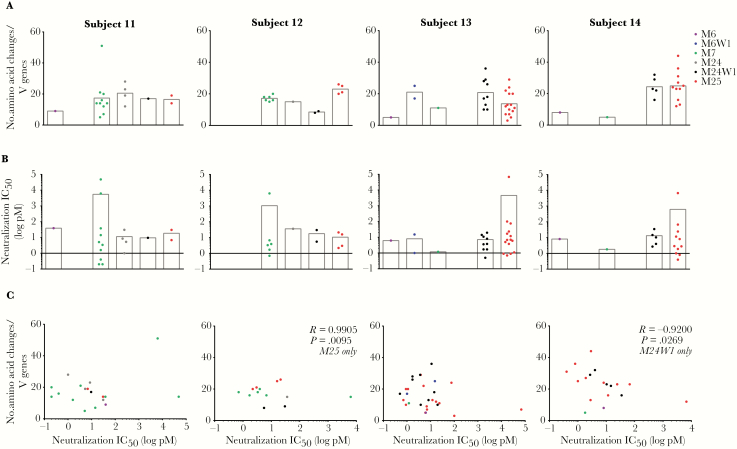Figure 3.
No evidence of human papillomavirus type 16 (HPV-16)–specific memory B cell (Bmem) affinity maturation beyond third quadrivalent HPV (4HPV) vaccine dose. Antibodies (Abs) cloned from HPV-16+ Bmem isolated at M6 (when the third dose was received), M6W1, M7, M24 (when the booster dose was received), M24W1, and M25 were analyzed for somatic hypermutation and neutralization potency. Only neutralizing monoclonal Abs are shown here. A, The level of somatic hypermutation is represented by the number of amino acid changes from germline in the Bmem’s variable genes (heavy and light Ab chains combined). B, The concentration (log pM) at which each Bmem-derived Ab inhibited 50% of HPV-16 pseudovirus (psV) infection in a neutralization assay, or neutralization IC50, is also shown. An IC50 below zero represents more potent activity. C, The level of somatic hypermutation for each Bmem-derived Ab was plotted against its neutralization IC50. Each dot represents an Ab and is colored by time point. For all Bmem -derived Abs characterized, only 2 statistically significant correlations were observed within a subject for a given time point, and they showed opposing correlations: A positive correlation between somatic hypermutation and neutralization potency was observed for Bmem-derived Abs in subject 12 at M25, indicating that with increasing somatic hypermutation, these Abs exhibited weaker neutralization activity. This positive correlation signifies a lack of affinity maturation. In contrast, a negative correlation was observed between somatic hypermutation and neutralization potency in subject 14 at M24W1, indicating that with increasing somatic hypermutation, Bmem-derived Abs exhibited more potent neutralization activity, signifying affinity maturation. Pearson correlation coefficient (R); P < .05 indicates statistical significance.

